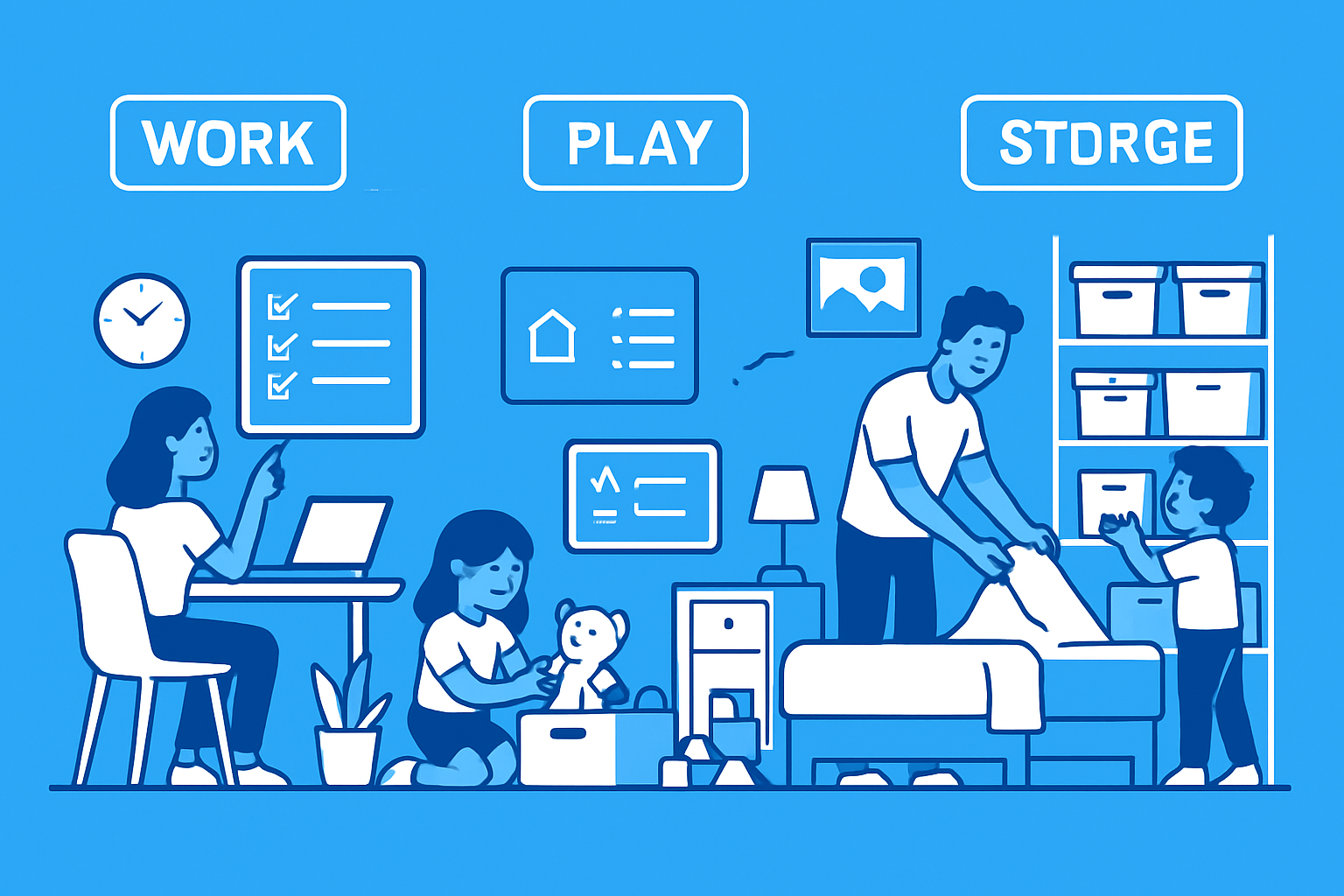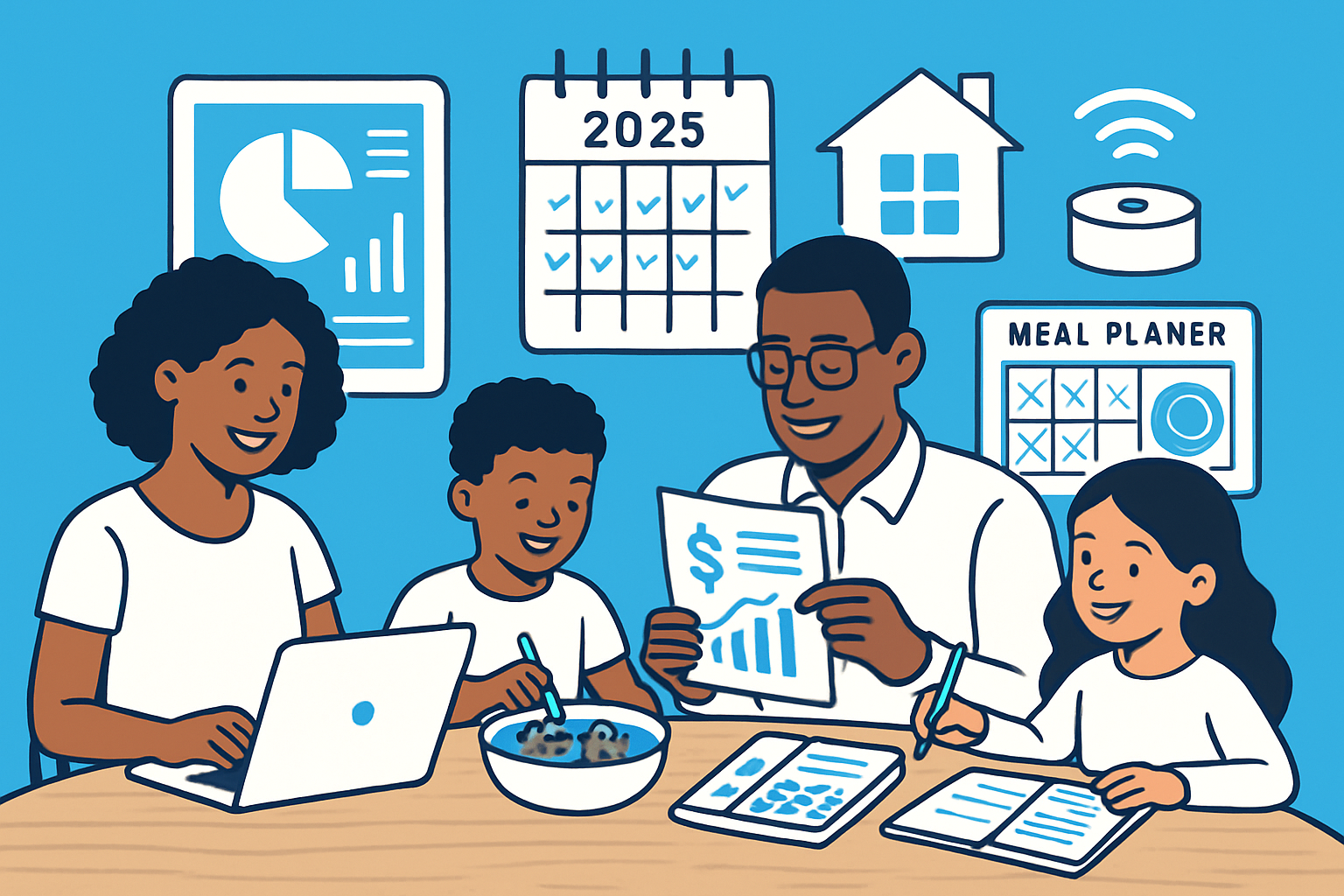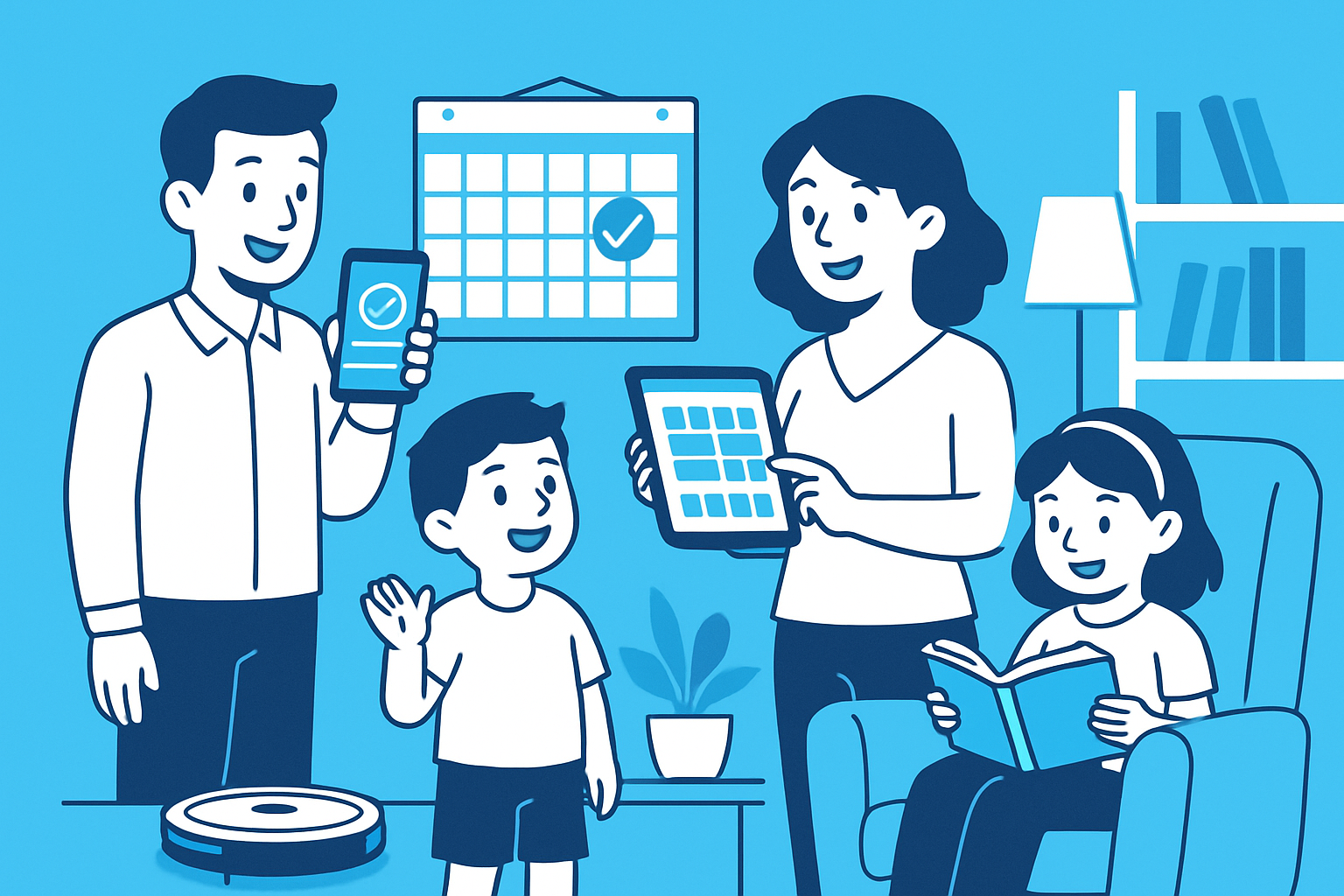Imagine waking up to a home where every detail is in sync, chores are streamlined, and every family member feels empowered. It’s not a distant dream, but a reality you can build with the right approach.
This home management guide delivers the blueprint you need for 2025. You’ll discover proven strategies, digital tools, and expert insights to create a more efficient, harmonious, and resilient household.
Ready to make your home a true sanctuary? Dive in to find step-by-step planning, financial tips, streamlined routines, and communication tactics designed to help your family thrive.
The Foundations of Effective Home Management
Imagine walking into a home where everything flows, responsibilities are shared, and technology works quietly in the background to make life easier. That’s the new reality of home management in 2025. Whether you’re running a bustling family household or living solo, mastering the art of home management can transform daily chaos into harmony.

Understanding Modern Home Management
Home management in 2025 is a blend of tried-and-true routines and innovative digital solutions. As remote work and tech adoption reshape our lives, households now rely on both tradition and technology to stay on track. Did you know that over 60% of households use digital planners and smart devices to manage daily tasks?
This shift is more than a trend—it’s a necessity. Proactive home management means anticipating needs before they become problems. For instance, families are integrating smart devices for tracking chores and automating reminders. According to Smart Home Statistics 2025, smart home adoption is saving families time and reducing stress.
Embracing these changes helps your home run smoothly and efficiently, turning everyday management into a seamless experience.
Setting Home Management Goals
Effective home management starts with clear, achievable goals. Setting objectives gives your household a sense of direction and purpose. Think about daily routines, financial stability, or family wellness—each can become a target.
Using the SMART goals framework (Specific, Measurable, Achievable, Relevant, Time-bound) makes these aims realistic. For example, you might aim to reduce utility bills by 15% in six months. When everyone knows the goal, accountability increases and progress becomes visible.
Involving all family members in the goal-setting process ensures everyone feels invested in your home management journey.
Building a Home Management System
A robust home management system covers scheduling, budgeting, cleaning, maintenance, and family communication. The right system can be digital, paper-based, or a mix of both.
All-in-one apps like Cozi or Google Calendar help centralize tasks and schedules. Creating a “command center”—maybe a calendar on the fridge or a digital dashboard—keeps everyone informed.
Here’s a quick comparison table of system options:
| System Type | Pros | Cons |
|---|---|---|
| Digital Apps | Syncs instantly, mobile access | Tech learning curve |
| Paper Planners | Tangible, visual | Harder to update |
Choose what fits your lifestyle best, but make sure your home management system is easy to use and accessible to everyone.
Delegation and Family Involvement
Shared responsibility is essential for successful home management. Assigning age-appropriate chores to children not only teaches life skills but also reduces parental burnout.
Research shows that households with shared chores report 30% higher satisfaction. Try making a list of weekly tasks and rotating them among family members. For younger kids, gamify chores with reward systems or colorful charts.
If you encounter resistance, offer incentives or celebrate small wins. When everyone pitches in, home management becomes a team effort, strengthening family bonds.
Overcoming Common Home Management Challenges
Modern life is busy, and home management can feel overwhelming. Time constraints, information overload, and disorganization are common hurdles.
To tackle these challenges, consider automation (like smart reminders), batching similar tasks, and holding regular family meetings. For example, set aside time each week to review schedules and assign responsibilities together.
Remember, progress is more important than perfection. Adopting a flexible mindset and celebrating small victories will keep your home management strategy resilient and effective.
Step-by-Step Home Organization for 2025
Is your home ready for the future? A modern approach to home management means breaking things down into manageable steps. Let’s walk through a practical, six-part process to transform your space and routines for 2025.

Step 1: Assessing Your Home’s Needs
Start your home management journey with a thorough audit. Walk through each room and take note of clutter, unused items, and inefficiencies. Pay special attention to high-traffic areas like the kitchen, entryway, or living room.
Use checklists to document what needs improvement. For example, write down expired pantry goods or gadgets collecting dust. This step helps you see the bigger picture and prioritize tasks.
By assessing your space, you lay a strong foundation for effective home management and prevent future overwhelm.
Step 2: Decluttering and Simplifying
Decluttering is key to stress-free home management. Removing excess helps you create space and clarity. Try methods like the KonMari approach or the 20/20 rule—if you can replace it in 20 minutes for under $20, let it go.
Break decluttering into monthly challenges, and consider donating or recycling what you no longer need. According to research, 54% of people feel more relaxed after decluttering.
Explore the Organize Yourself Healthy Method for a holistic approach that boosts both your space and well-being.
Step 3: Creating Functional Zones
Dividing your home into functional zones is a powerful home management strategy. Define areas for work, play, rest, and storage. Use furniture and storage solutions to keep each zone purposeful.
Set up homework stations, reading nooks, or mudroom cubbies to streamline routines. When every item has a dedicated place, daily life becomes smoother for everyone.
Organized zones support your home management goals and make it easy for family members to find what they need.
Step 4: Establishing Maintenance Routines
Consistency is at the heart of effective home management. Create daily, weekly, and monthly cleaning schedules. Automate reminders with smart devices or phone alerts to keep everyone on track.
Examples include setting specific laundry days or using a robot vacuum for daily tidying. Small, regular efforts prevent messes from piling up and reduce stress.
Maintenance routines ensure your home management system stays strong and sustainable all year long.
Step 5: Organizing Important Documents and Information
Centralizing documents is a must for modern home management. Gather vital records, warranties, and manuals in one secure spot. Choose between digital storage (with password protection) and physical files in a fireproof safe.
Try color-coding folders or using labeled binders for quick access. This saves time during emergencies and keeps your household running smoothly.
A reliable document system is an essential part of home management, supporting both security and efficiency.
Step 6: Leveraging Home Management Tools
In 2025, digital tools are transforming home management. Use task managers, inventory trackers, and shared grocery lists to stay organized. Popular apps help reduce duplicate purchases and streamline routines.
Select tools that match your household’s needs and preferences. Data shows that 75% of organized households use at least one productivity app.
By embracing technology, your home management process becomes seamless, collaborative, and future-ready.
Financial Management for a Thriving Household
A thriving household in 2025 runs like a well-oiled machine, and effective home management is at the heart of financial stability. With rising costs and shifting lifestyles, mastering your household’s finances is more important than ever. Let’s break down the essential steps for building a strong financial foundation for your home.

Budgeting for 2025
Start by creating a realistic and adaptable budget that reflects your home management goals. Track all income sources and categorize every expense, from groceries to streaming services. Use digital budgeting apps or spreadsheets to visualize spending patterns and set clear savings objectives.
One popular approach is zero-based budgeting, where every dollar is assigned a purpose. This method ensures nothing slips through the cracks. Include a budget review session in your monthly home management routine to adjust for any changes. Planning ahead with a solid budget brings peace of mind and keeps your household on track.
Managing Bills and Subscriptions
Keeping up with bills and recurring subscriptions is a core element of successful home management. Missed payments can lead to unnecessary fees, so set up reminders or automate payments wherever possible. Review all subscriptions regularly, canceling those you no longer use.
Leveraging technology can make this process seamless. For example, emerging property management software trends offer automated tools to track and pay bills efficiently. Households that actively manage their subscriptions save up to $500 annually, freeing up funds for other home management priorities.
Emergency Planning and Savings
Unplanned expenses are inevitable, so proactive home management includes building a robust emergency fund. Aim to save three to six months’ worth of living expenses. Review your insurance policies—health, home, and auto—to ensure adequate protection.
Consider setting up sinking funds for irregular costs like repairs or holidays, making your finances more resilient. Statistics show only 39% of Americans are prepared for a $1,000 emergency. By prioritizing savings and preparedness, your home management plan will help your family weather any storm.
Smart Shopping and Meal Planning
Smart shopping is a cornerstone of home management. Buy in bulk, use coupons, and embrace meal prepping to stretch your grocery budget further. Planning meals in advance reduces food waste and saves time during busy weeks.
Adopt digital grocery list apps to keep everyone on the same page and prevent duplicate purchases. Studies reveal that families who meal plan as part of their home management routine cut grocery bills by up to 20%. A little preparation goes a long way toward a healthier budget and happier kitchen.
Teaching Family Financial Literacy
Empowering every family member with financial know-how is vital for long-term home management success. Start with age-appropriate money lessons for kids—like earning an allowance tied to chores—to instill good habits early.
Hold regular family meetings to discuss budgets, goals, and spending choices. Encourage teens to save and make smart decisions. Data shows that financially literate teens are twice as likely to save regularly. By making financial literacy part of your home management culture, you’re setting your household up for a thriving future.
Streamlining Routines and Schedules
Creating order in your day-to-day life is a cornerstone of successful home management. With the right routines, every member of your household can thrive—balancing work, chores, and relaxation without feeling overwhelmed.

Crafting the Ideal Daily and Weekly Routine
Establishing effective routines is the backbone of home management. Begin by mapping out your mornings, afternoons, and evenings, considering every family member’s commitments.
Try block scheduling to group similar tasks together, such as meal prep and laundry. This approach helps reduce decision fatigue and keeps everyone on track.
- Morning: Prepare breakfast, review the day’s plan
- Afternoon: Schoolwork, errands, chores
- Evening: Family time, relaxation, prep for tomorrow
Consistent routines support smoother transitions between activities and reduce daily stress. Remember, a flexible routine is more sustainable than a rigid one, allowing your home management plan to adjust when life gets busy.
Synchronizing Family Schedules
Coordinating everyone’s activities can be challenging, but digital tools make it easier than ever. Shared calendars, like Google Calendar, allow all family members to see appointments, deadlines, and events in real time.
Set up recurring reminders for key tasks and use color-coding to differentiate between work, school, and leisure activities. According to Home Care Industry Statistics 2025, families embracing digital solutions have seen significant improvements in organization and time management.
With synchronized schedules, home management becomes a team effort, reducing missed events and last-minute stress.
Managing Chores and Responsibilities
Assigning chores fairly is vital for balanced home management. Use rotating chore charts to ensure everyone shares the workload, preventing resentment and burnout.
Gamify chores with apps or reward systems to motivate kids—many families report increased participation when tasks feel like a fun challenge. For example, set up a points system where completed chores earn small rewards or privileges.
- Rotate tasks weekly to keep things fresh
- Use visual charts or digital apps
- Celebrate milestones to encourage consistency
When everyone knows their responsibilities, your home runs more smoothly and efficiently.
Prioritizing Self-Care and Downtime
Effective home management isn’t just about getting things done—it’s about nurturing well-being. Schedule regular breaks, hobbies, and family fun into your routines.
Block out time for self-care, whether it’s a solo walk, reading hour, or a family movie night. Downtime is linked to higher life satisfaction and helps prevent burnout.
- Weekly family game nights
- Quiet reading time for all ages
- Outdoor activities for relaxation
Prioritizing rest ensures your home management system supports both productivity and happiness.
Adapting to Change and Staying Flexible
Even the best home management plans face unexpected disruptions. Embrace flexibility by building “buffer time” into your routines for handling last-minute changes.
Adopt a mindset of progress over perfection. For example, flexible meal planning lets you swap meals if schedules shift, and regular check-ins help everyone adjust quickly.
- Allow extra time between appointments
- Review routines weekly for improvements
- Stay open to new tools and methods
With a flexible approach, your home management strategy will remain resilient, no matter what life brings.
Communication and Collaboration in the Modern Home
Effective communication and collaboration are the heartbeat of successful home management. In today’s fast-paced world, fostering open dialogue and teamwork helps every household member feel involved, heard, and empowered. Let’s explore key ways to build a connected, cooperative home environment.
Establishing Open Communication Channels
Open communication forms the backbone of effective home management. Regular family meetings create space for everyone to share thoughts, concerns, and ideas.
Set a clear agenda and encourage each member to participate. Weekly check-ins help clarify goals, schedules, and challenges. This routine ensures no one feels left out or overwhelmed.
- Share updates openly
- Rotate who leads the meeting
- Celebrate small wins together
Families who prioritize open dialogue report fewer conflicts and greater harmony. Consistent communication keeps your home management strategies on track.
Digital Tools for Family Collaboration
Modern home management thrives with digital support. Messaging apps, shared calendars, and note-taking platforms keep everyone on the same page.
Popular options include Google Calendar, WhatsApp, and shared grocery list apps like OurGroceries. These tools offer real-time updates and reminders, reducing missed appointments and forgotten chores.
- Group chats for instant updates
- Shared to-do lists for task tracking
- Digital calendars for event planning
For more ideas, explore this guide to top family organization apps. The right digital tools make home management smoother and more collaborative.
Conflict Resolution and Problem-Solving
Conflicts are natural, but proactive problem-solving is essential for positive home management. Start with active listening—give each person time to speak without interruption.
Practice empathy by acknowledging feelings and perspectives. Use structured steps to resolve disagreements, such as listing potential solutions and weighing pros and cons together.
- Hold “solution circles” for recurring issues
- Create a safe space for honest feedback
- Agree on clear action steps
Homes with open communication see up to 30% less tension. Addressing challenges together strengthens your home management foundation.
Fostering Teamwork and Shared Responsibility
Home management flourishes when everyone contributes. Celebrate achievements, whether it’s a clean kitchen or a successful project.
Rotate leadership roles for family tasks, letting kids plan outings or handle meal prep. Shared responsibility builds life skills and deepens family bonds.
- Assign age-appropriate chores
- Recognize teamwork with small rewards
- Reflect on milestones as a group
Focusing on teamwork ensures your home management approach is sustainable and rewarding for every member.
Future-Proofing Your Home Management Strategy for 2025 and Beyond
Looking ahead, home management is evolving rapidly. Adapting your approach ensures your household thrives, no matter what the future brings. Let’s explore four essential ways to future-proof your home management strategy for 2025 and beyond.
Embracing Smart Home Technology
Smart technology is reshaping home management by making daily life more efficient and secure. Devices like voice assistants, smart thermostats, and connected appliances simplify chores and save time.
Consider this quick comparison:
| Device Type | Main Benefit | Example Impact |
|---|---|---|
| Smart Thermostat | Energy savings | Cuts bills by up to 10% |
| Voice Assistant | Task automation | Hands-free reminders, controls |
| Smart Security | Enhanced safety | Remote monitoring, alerts |
Families using smart home tech often report smoother routines. Before investing, weigh factors like privacy, upfront cost, and compatibility with your existing home management setup.
Sustainability and Eco-Friendly Practices
In 2025, sustainable home management means more than recycling. It’s about adopting habits and tools that reduce your home’s environmental impact and operating costs.
Try these eco-friendly ideas:
- Compost kitchen scraps and recycle consistently.
- Upgrade to energy-efficient appliances and LED lighting.
- Install solar panels or water-saving fixtures.
Minimalism and mindful consumption can also simplify your space. Data shows eco-friendly homes have 15% lower yearly costs, proving that sustainable home management is both responsible and rewarding.
Continuous Learning and Improvement
Home management isn’t static—it evolves with new trends and tools. Stay on top of best practices by exploring online courses, reading expert blogs, and joining supportive communities.
Great resources include:
- Home organization podcasts
- Online workshops and webinars
- Dedicated home management forums
Regularly review your systems to spot what’s working and what needs updating. By prioritizing continuous learning, you’ll keep your home management skills sharp and adaptable.
Building Resilience and Preparedness
Resilient home management prepares your family for the unexpected. Start by developing emergency plans: stock essential supplies, keep contact lists handy, and map evacuation routes.
Don’t overlook mental health. Encourage open conversations about stress and coping strategies. Schedule family emergency drills twice a year to build confidence and readiness.
Prepared households bounce back faster from disruptions. Making resilience a core part of home management ensures your family is equipped for whatever comes next.
If you’re ready to take your home from chaos to calm and truly put these strategies into action, there’s an easy way to get started. I know how overwhelming it can feel trying to keep track of everything—finances, routines, important documents, and family schedules. That’s why having one organized, accessible place for all your household info makes such a difference. With The Family Binder, you can simplify your life, boost your peace of mind, and make sure everyone knows exactly where to find what they need. Ready to create your own blueprint for success? Download Now

